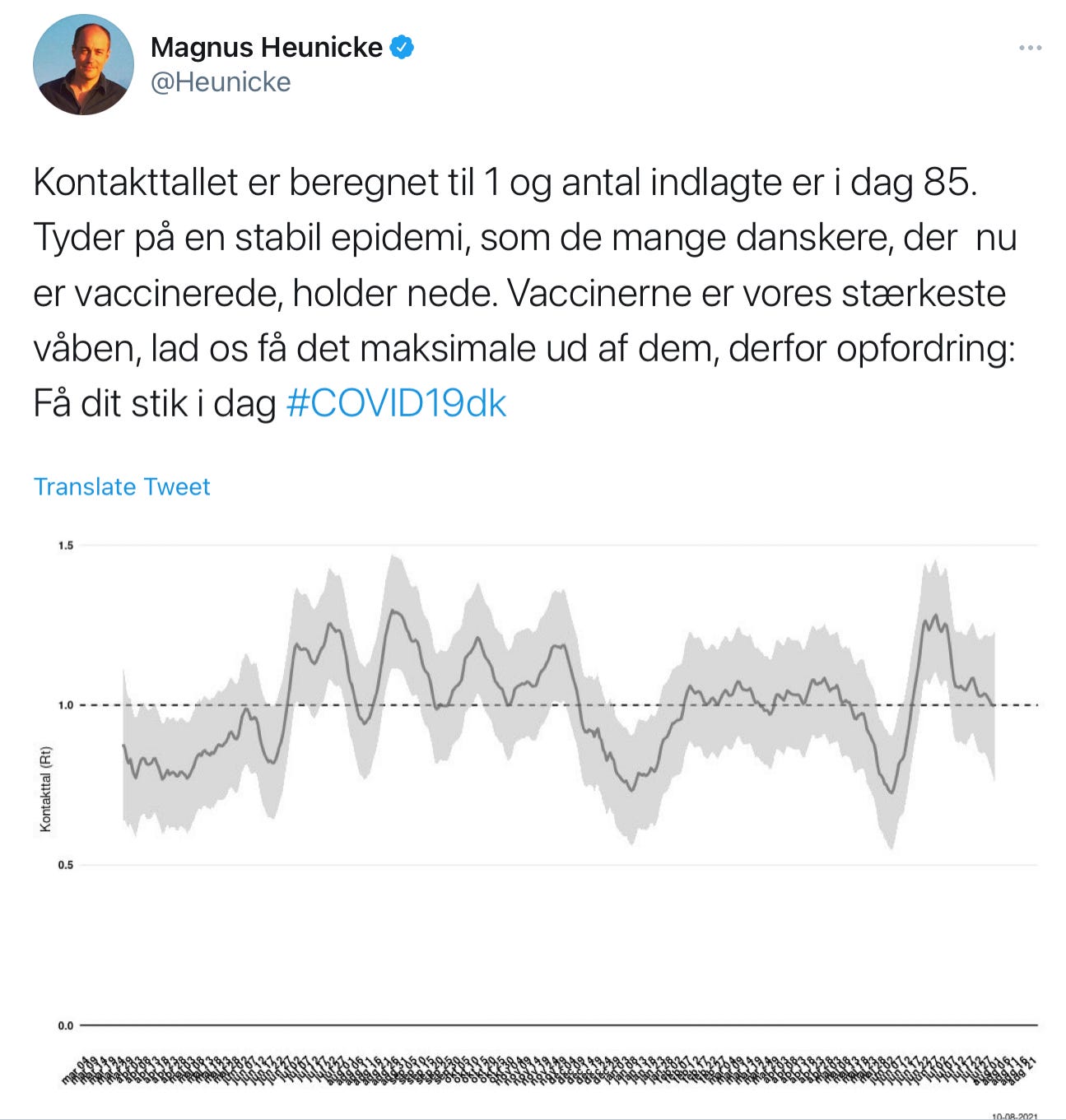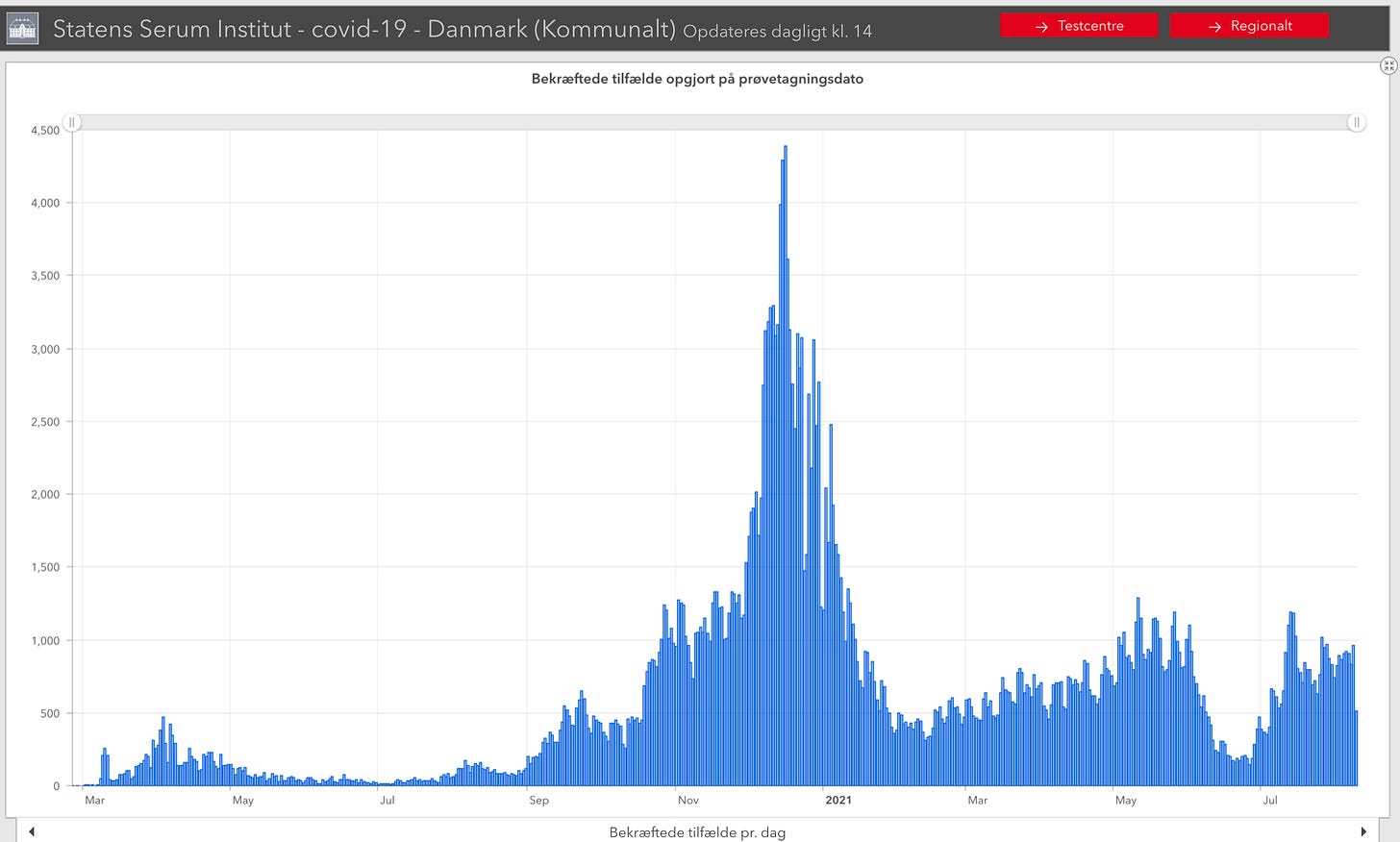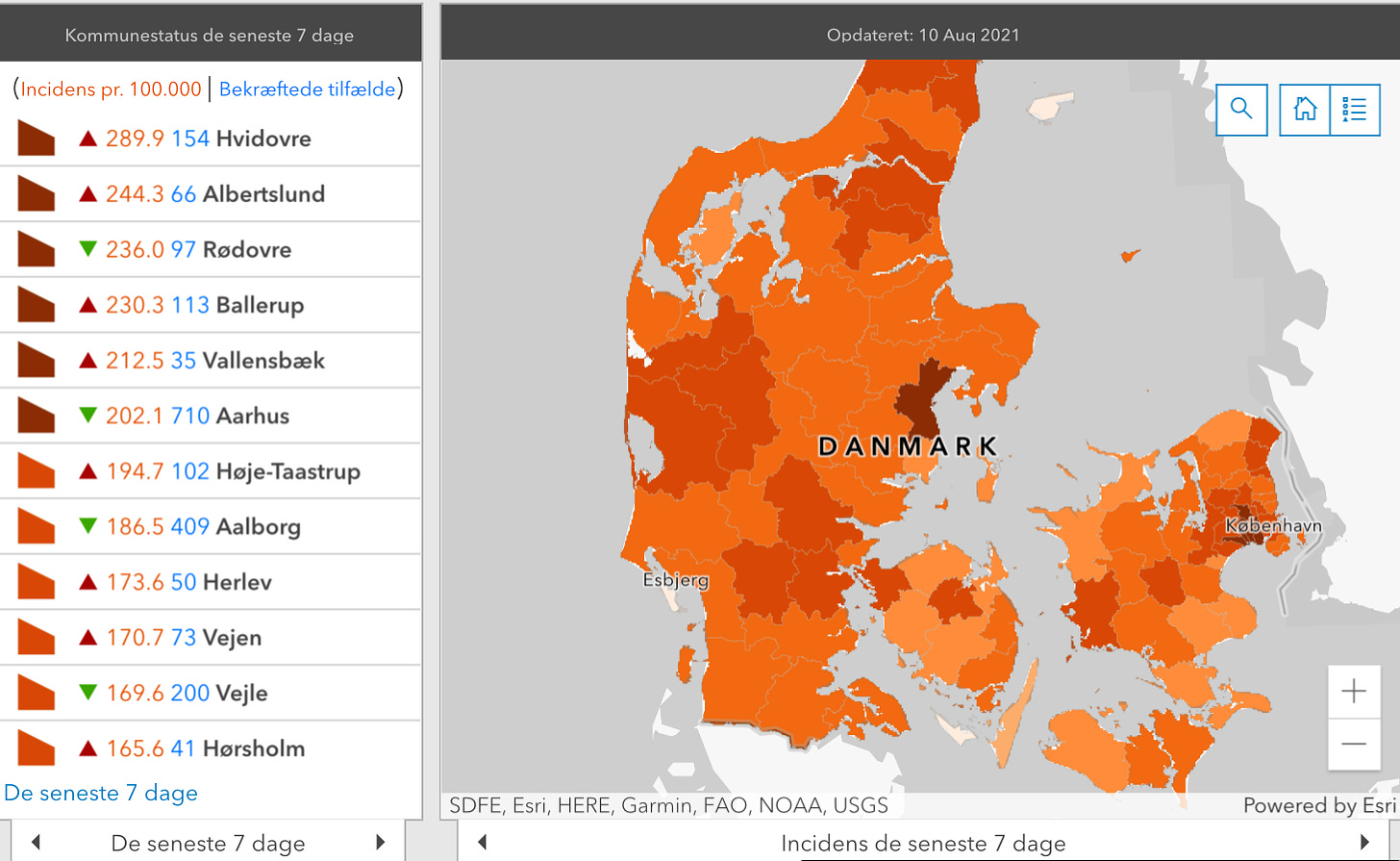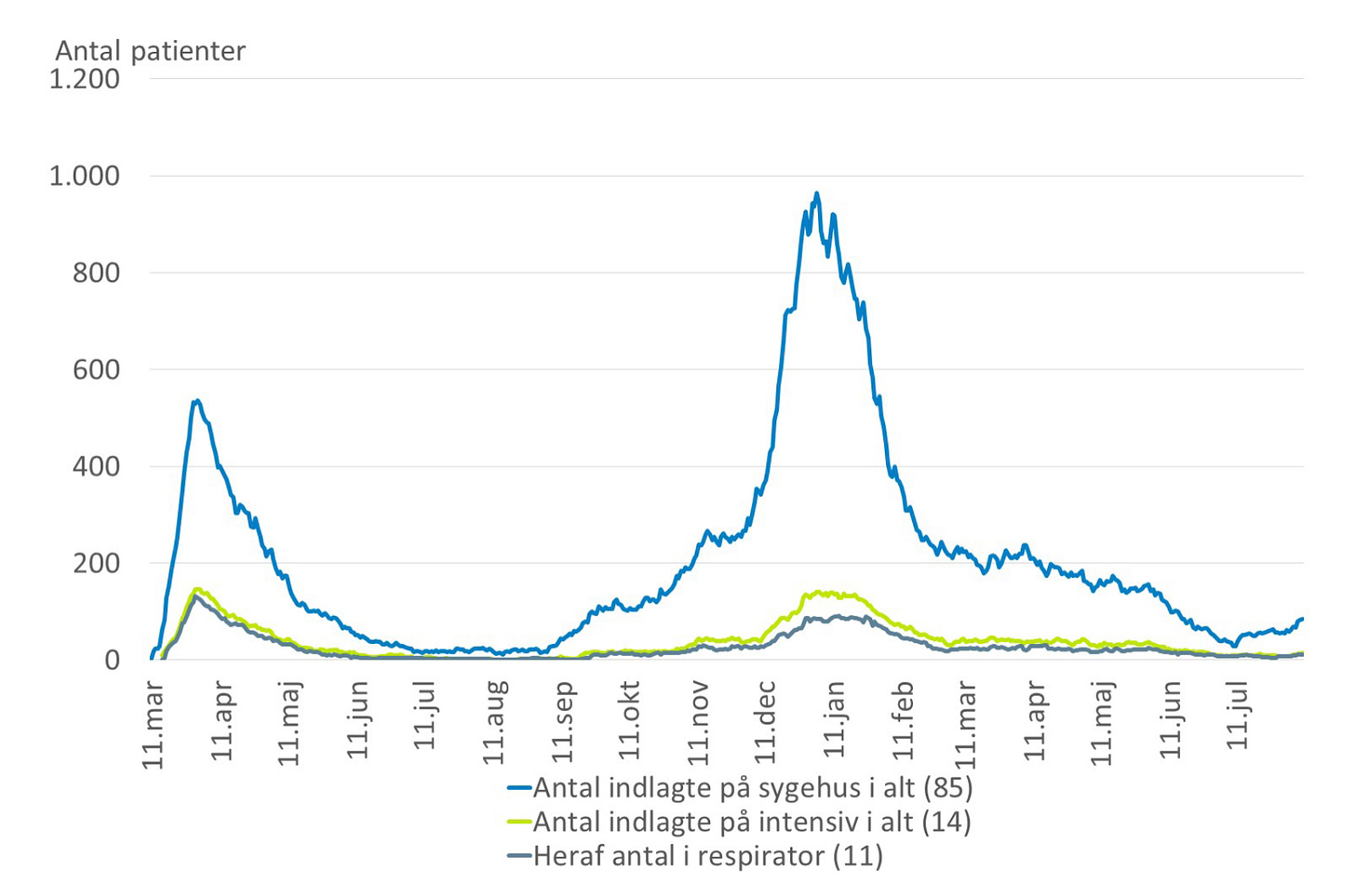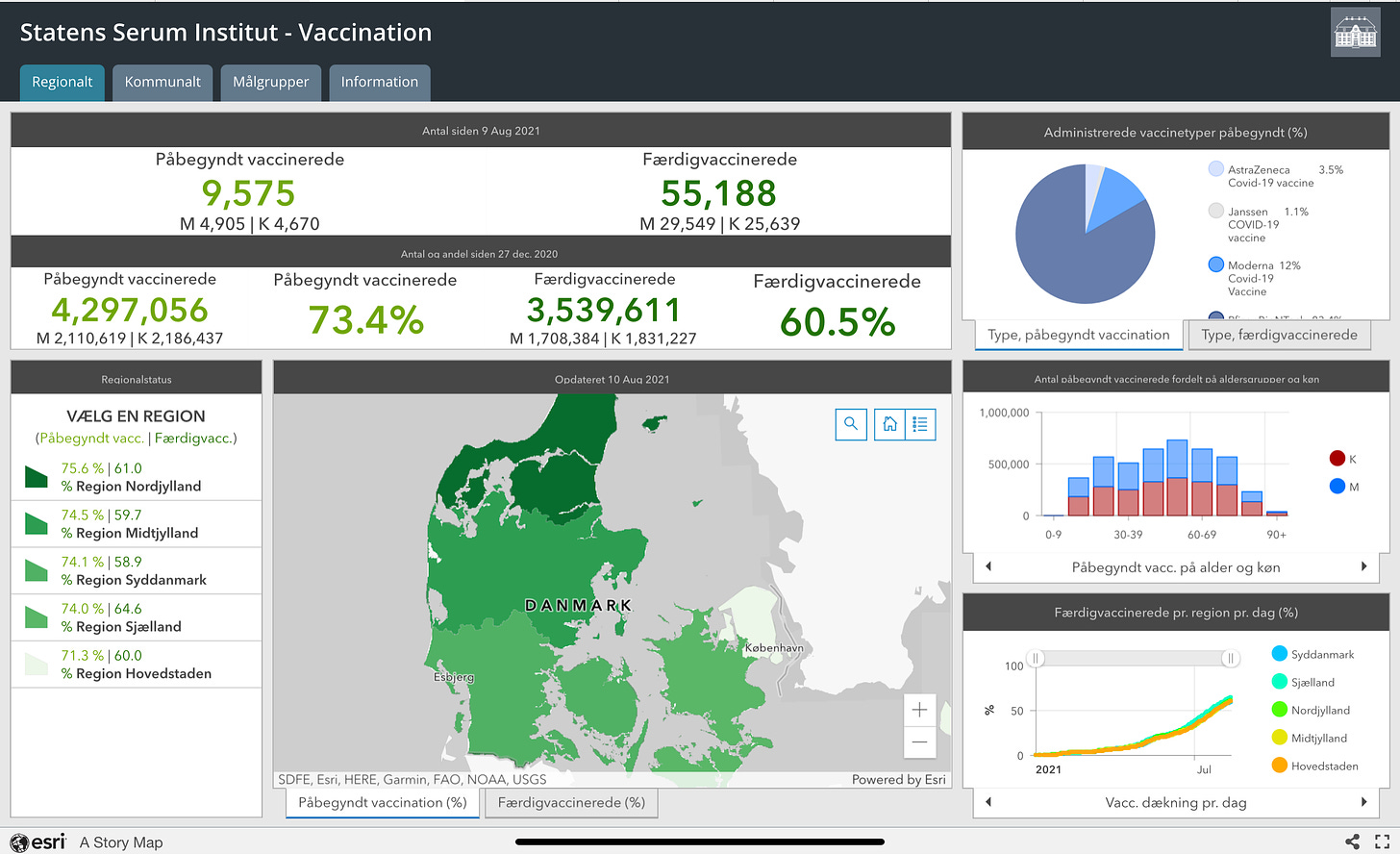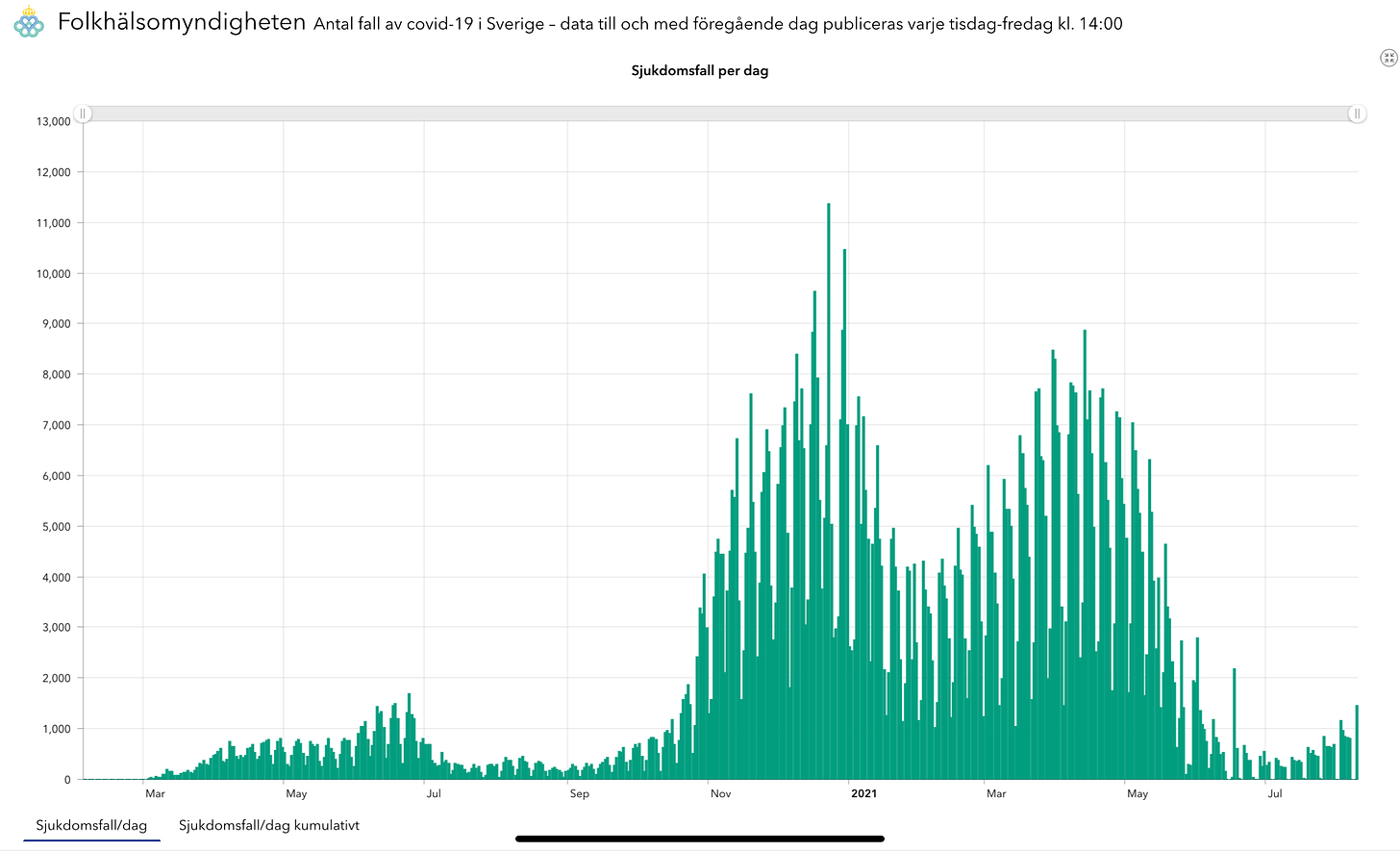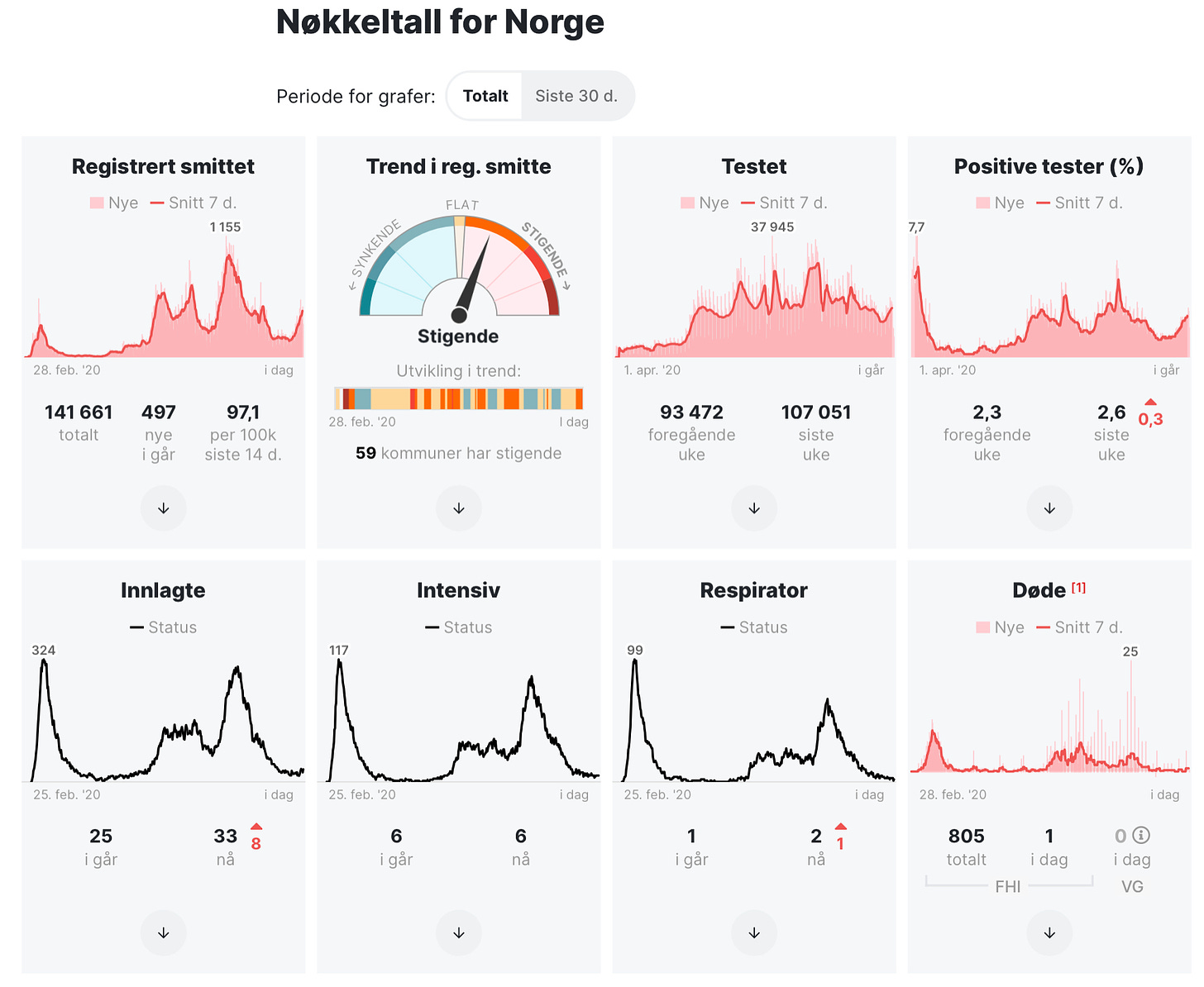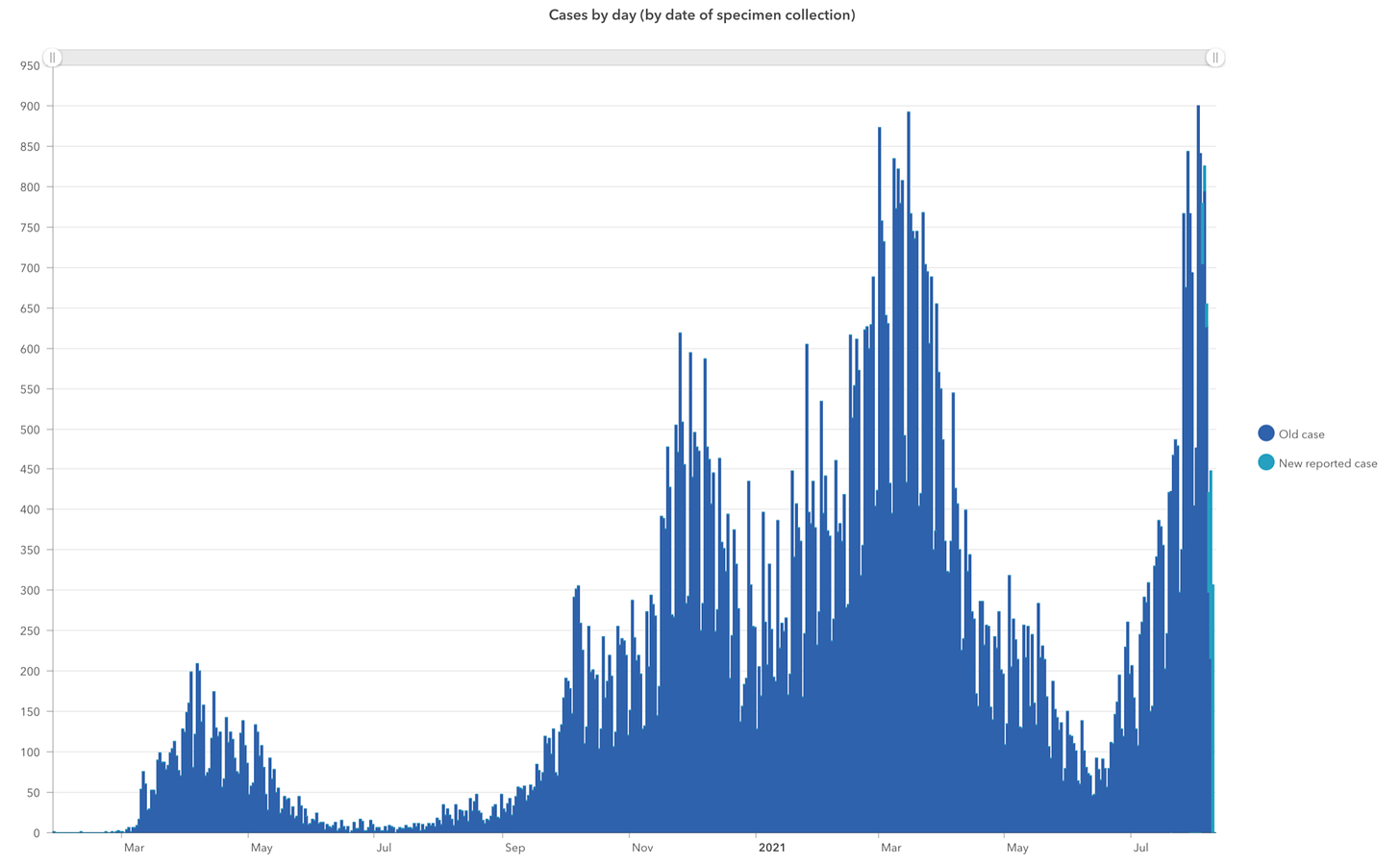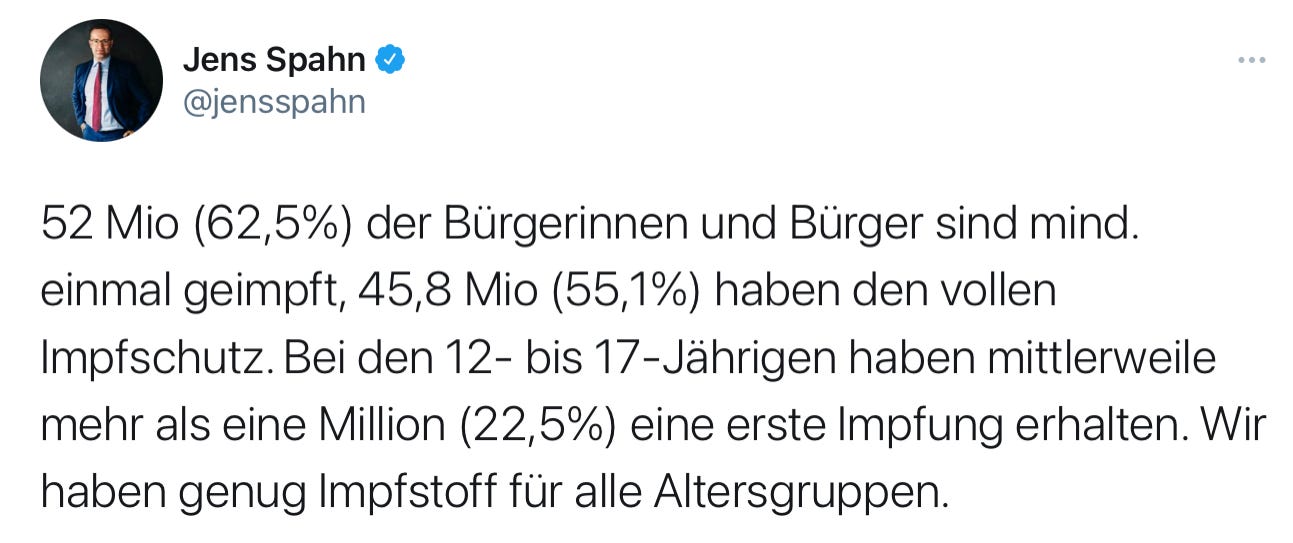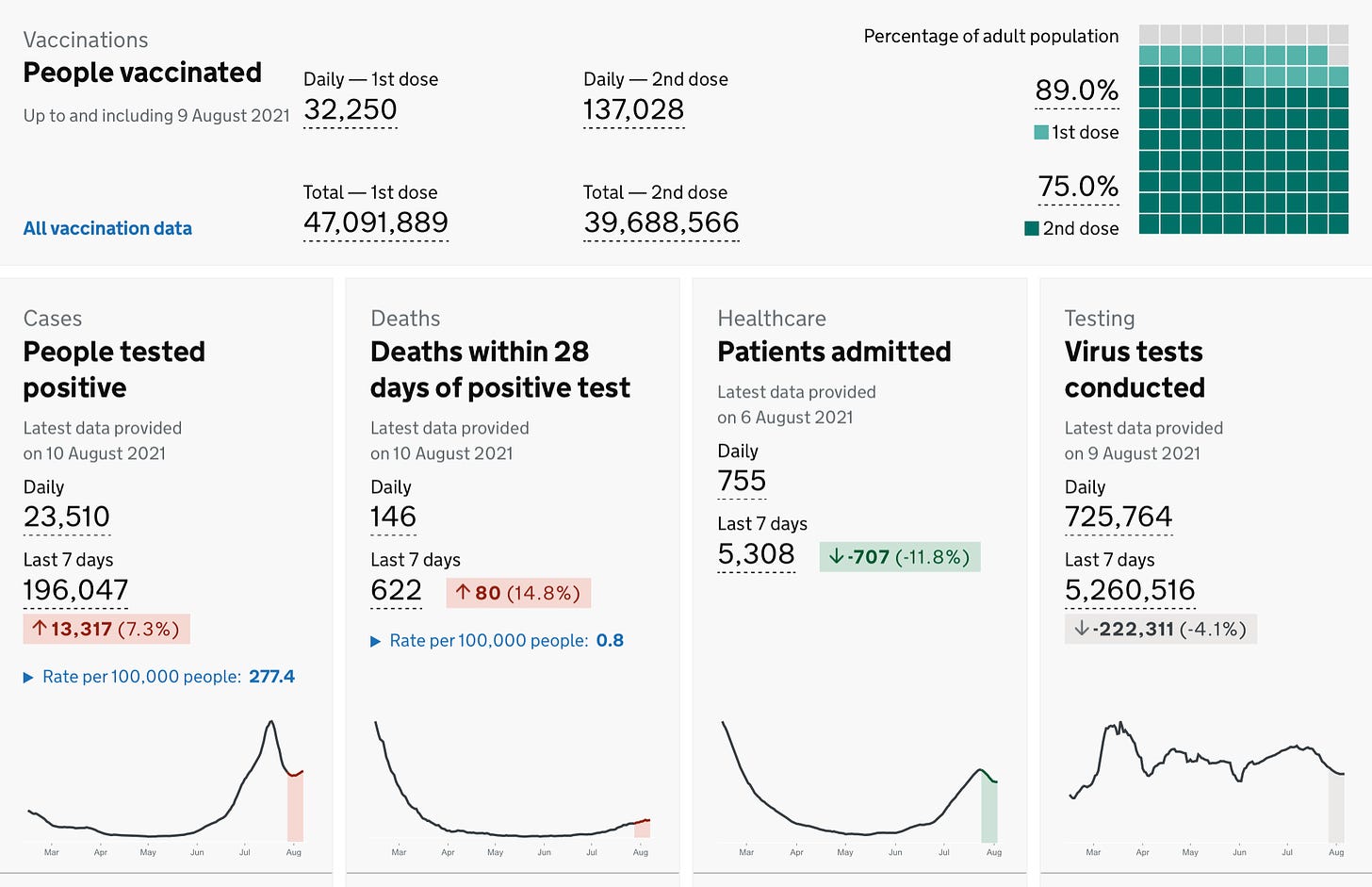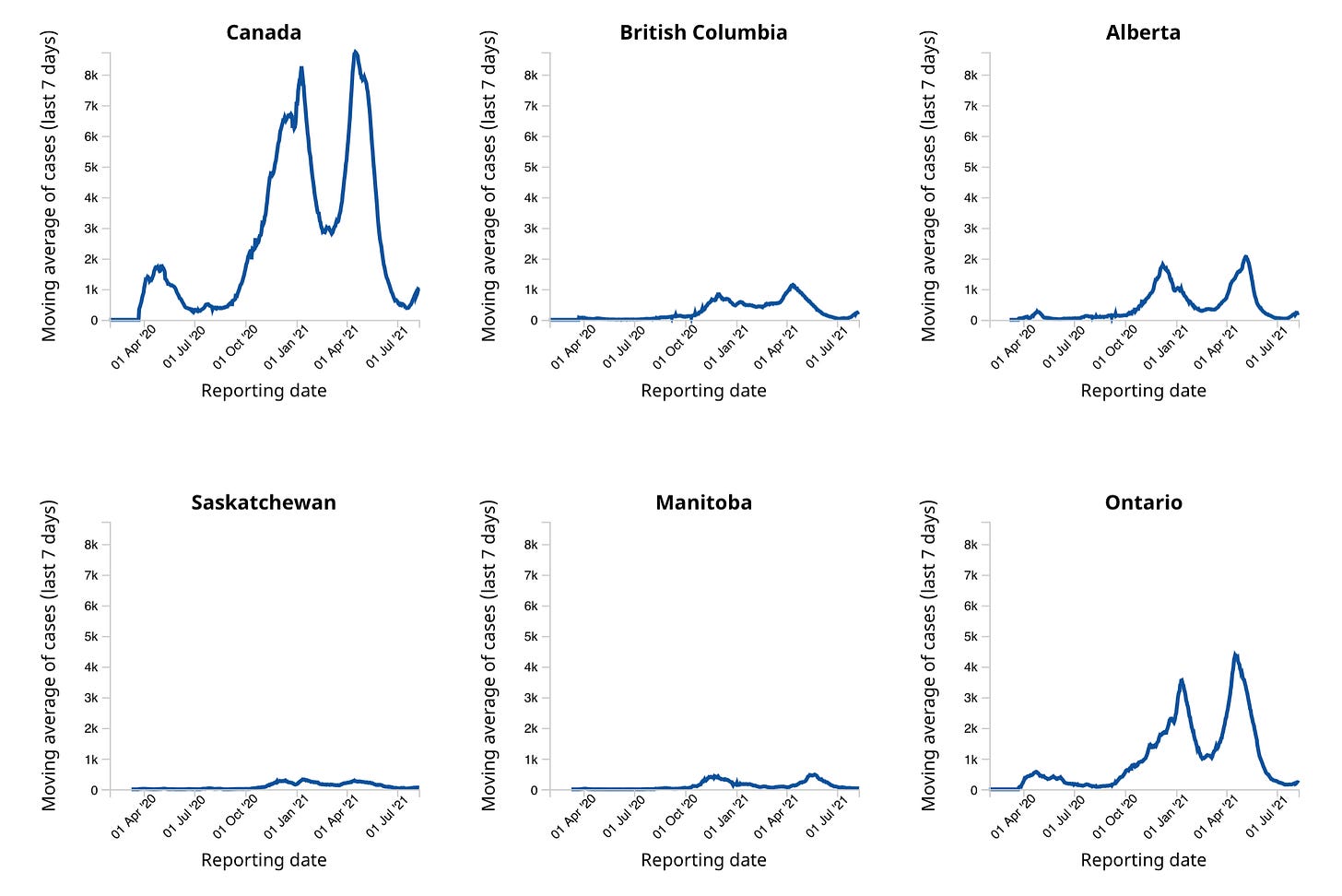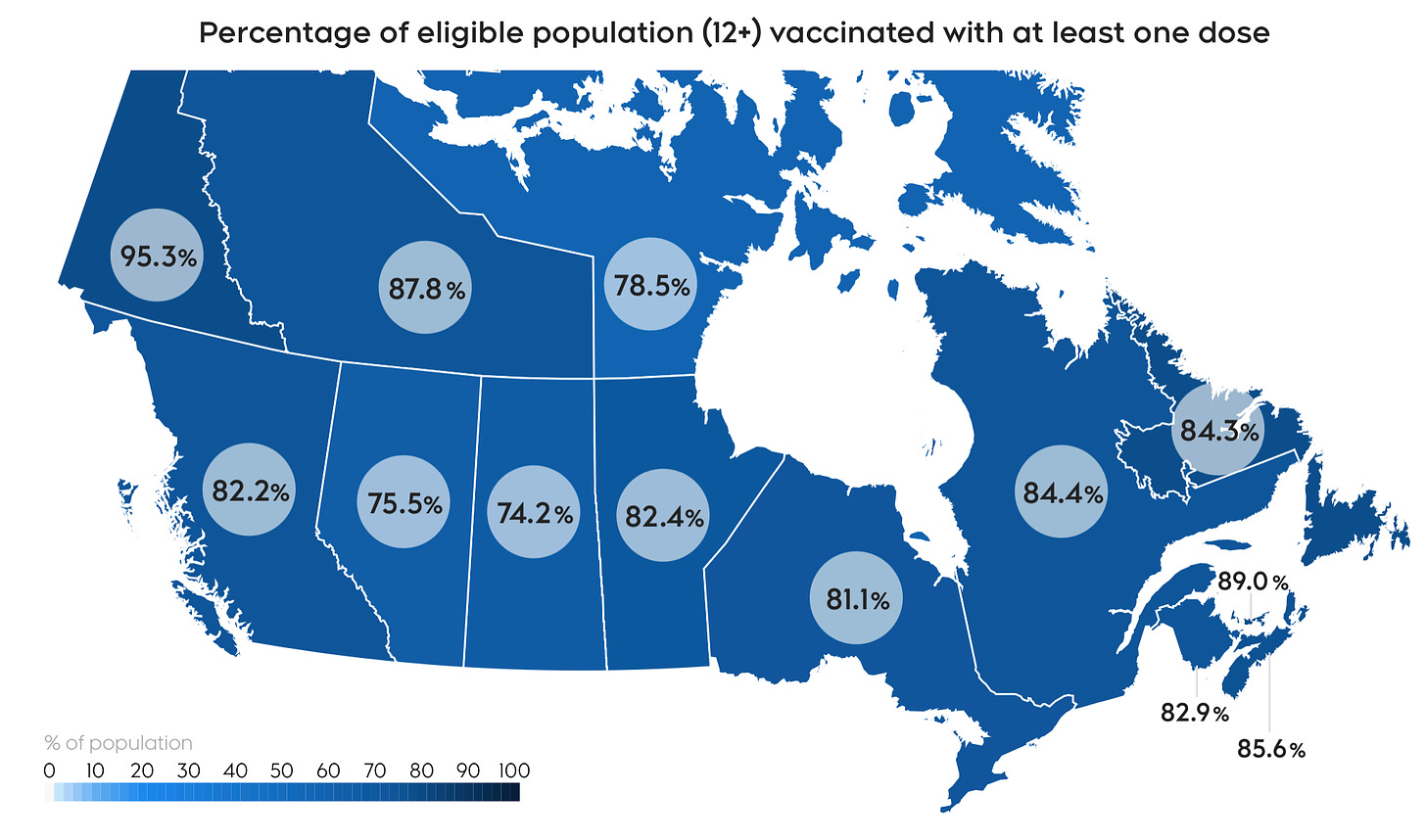The Evening Report - Aug 10
Denmark’s COVID situation remains stable but not so much elsewhere in the Nordics
🇩🇰
For a third consecutive week, Denmark’s COVID contact number (reinfection rate or R0) remains at 1.0. Health Minister Magnus Heunicke says the epidemic situation remains stable. He credits the vaccination effort and urges anyone who has not yet to go get vaccinated.
-
DR has found at least five municipalities among 56 it contacted who no longer offer COVID testing on school grounds. Authorities currently recommend any student 12 years old and older who isn’t vaccinated to get tested for COVID twice a week. In Slagelse Kommune, for example, the national broadcaster found that not only do schools no longer offer testing, but the local testing center also closed. The nearest place to get tested is now at least eight kilometers away.
School Board Chair Tine Samsø:
“This means that you have to find the time after school and work, and for many families it will be difficult to find the time to get it done twice a week, even if it is recommended. I think there are many families who will not get it done. And it will have consequences if the infection increases.”
The kommune told DR that if infections increase and there are outbreaks in schools, it can quickly take action. For example, it has an agreement in place with Falck to provide rapid testing at any school needing it.
Viggo Andreasen, who is an associate professor of mathematical epidemiology at Roskilde University, says this does not pose an immediate problem.
“That corona spread in schools is probably something that is not relevant right now, but in a little while the dark, cold winter will come, and then COVID will probably become so widespread that it can be transmitted in primary schools.”
Andreasen adds an overall reduction in testing sites means fewer people getting tested, something he called “problematic” for keeping COVID cases down and keeping the virus out of primary schools.
-
A Danish company is touting preliminary results from clinical trials of its COVID vaccine. In press release, Bavarian Nordic says the first trials on humans found few side effects, a strong booster effect, very high antibody levels, and neutralization of COVID variants, including the Delta strain. The first human trials involved 45 people in the Netherlands.
President and CEO of Bavarian Nordic Paul Chaplin:
“We are very pleased to report positive results from this first-in-human trial of our COVID-19 vaccine, confirming its ability to induce strong and broad antibody levels, superior to those of the current approved vaccines, while also providing a favorable safety profile. These data are highly encouraging for our planned Phase 2 trial later this month, which is designed to evaluate the vaccine’s potential as a universal booster vaccine.”
Final clinical trial results are expected later this year. Phase two trials, involving 210 participants, are scheduled to begin in August. Plans for phase three trials are currently being ironed out.
-
Denmark has reported 1,004 COVID infections today, along with two more coronavirus deaths. This marks the first time since July 30 that daily infection cases have risen above the 1,000 mark.
Yesterday, there were 148,233 total corona tests done, 60,676 PCR and 87,557 rapid, for a (PCR only) positivity percentage of 1.65%.
The number of Danish kommunes with a COVID incidence rate over 100 per 100,000 residents is now 33 and of those, six are seeing incidence rates above 200. The highest infection rates are in Denmark’s two largest cities, with one being Aarhus kommune and the other five all in Metro Copenhagen.
-
COVID hospitalizations (85) have edged upward again (+2) while the number of infected people in an ICU (14) also inched upward (+1) and of those, the number on a ventilator (11) is unchanged.
On the vaccination front to date, 73.4% of the population have had one vaccine dose while 60.5% are now fully vaccinated.
Yesterday, 64,763 total inoculations were done. The number of first doses picked up slightly but still remains under 10,000.
-
The Danish Medicines Agency is asking people to be cautious, with some new studies making news that claim that the Moderna vaccine is more effective against the Delta variant than Pfizer/BioNTech. Head of the Regulatory and Clinical Assessment Unit, Hanne Lomholt Larsen, cautioned that these are “preliminary studies with sparse data from the period when Delta has been dominant.” She says other studies have already shown that both vaccines provide high levels of protection against the Delta variant after having both doses.
-
Region Syddanmark has 83,100 vaccine doses to administer this week. Just over 52,000 are from Pfizer/BioNTech and the other 30,000 and change are from Moderna. That is down from the 109,880 doses the health region had available last week. Vaccinations are wide open to everyone 12 years old and up and the region is busy getting everyone vaccinated. To date, 903,906 people in the region (73.8%) have one dose while 706,077 people (57.6%) have finished their vaccinations.
-
Region Midtjylland has about 147,000 vaccine doses ready to go this week, with 95,000, from Pfizer and the other 52,000, from Moderna. The health region says it has 40,000 available times for first vaccinations and another 45,000 for second doses. So far, 922,300 people (74.2%) have had one dose and 776,700 (58.1%) have had both doses. For those aged 12 to 15 years old, 46.1% have one shot and 0.7% are fully vaccinated.
Beginning today, vaccination centers in midtjylland have begun offering shots without the need to book an appointment. The region says a “significant number” of people have now been vaccinated “who had difficulty using existing offers.”
The region is also preparing to deploy mobile vaccination sites to residential areas, where vaccination rates are low, as well as to different schools.
-
Several of Denmark’s health regions have taken to social media today to say people can now change their vaccination time without having to first cancel the old one. This allows people to move their vaccination appointment up without risking losing the one they initially had booked.
-
Denmark’s Foreign Affairs Ministry has moved Estonia from orange to yellow on its colour-coded COVID risk assessment map. It also shifted the Czech Republic to near-normal green. In both cases, it was not to do with the COVID situation in each country rather, both lifted entry restrictions on travelers from Denmark.
🇸🇪
Sweden has added 3,128 new infections and one more corona death since its update on Thursday, as its infection begins to rise again.
To date, 6,560,956 1st doses (80.1% of the adult population) and 4,581,328 2nd vaccine doses (55.9%) have been administered.
-
Region Stockholm says the number of COVID patients in capital region hospitals continues to increase. Maria Rotzén Östlund, Infection Control Doctor, says there are 57 people currently hospitalized, a 40% increase from last week.
“The development is worrying. It's going in the wrong direction. We have close to 2,000 new people became infected this week as we now enter a period where Stockholmers return to school and work. We have the most cases among young people under 30. Many of them are not yet vaccinated and thus susceptible to infection. Even young people can, in exceptional cases, become seriously ill. They can also infect others and thereby cause COVID to continue to gain a foothold in the population. We do not want that.”
The region adds that there are also a number of those who are in hospital who have had just one vaccine dose.
-
Most people flying back into Sweden from abroad and landing at the Landvetter's airport are not taking advantage of voluntary testing at the airport. Dagens Nyheter cites information from Västra Götaland region, in making the claim.
Region Sampling Coordinator Per Sikora:
“When you see these figures, you wonder if people really follow the recommendations that exist.”
Swedish health officials have been warning for weeks about the rising numbers of people returning from holiday hot spots who are infected with COVID.
🇳🇴
Norway has added 825 infections and had one more virus death since yesterday’s update.
COVID hospitalizations (35) are up (+8) ICU numbers (6) are unchanged and of those, the number on a ventilator (2) has crept up (+1).
To date, 68.87% of Norwegians have had one dose and 36.69% have had both
-
Norway could return to near-normal life by the end of September, according to the country’s Prime Minister and health minister. In an interview with Norwegian media outlet VG, Erna Solberg and Bent Høie say restrictions could vanish in a little over a month.
The Statsminister Erna Solberg says by the end of this week, everyone in Norway over the age of 18 will have been offered at least one vaccine dose.
“The second milestone is when people have received a second dose. Then the adult population is also well protected against being infected and infecting others. By the end of September, the adult population will probably have been offered a second dose.”
Health Minister Bent Høie confirms that, in theory, everyone should have a second dose by the end of September “then it will be possible to live normally.”
“Norwegian society will have to live with the fact that we have this virus, as we live with other infectious diseases. We cannot eliminate the risk completely, as we cannot with other diseases. This means that some will also become seriously ill and die of COVID after we have finished the vaccination and society has reopened.”
Erna Solberg was asked about what this means for children.
“When everyone has received dose two, young people will probably get it. We have so far said a conditional yes to 16-and 17-year-olds getting the vaccine. Then we also look at what is happening in Denmark, among other places, in the assessments of whether we should eventually also vaccinate children over 12 years old. They very rarely get seriously ill, so the question is what is the benefit of vaccinating.”
What about those under 12?
“So far no one was able to send in the perfect solution, which is not strange. There are some side effects of vaccination and we will look at experiences gained in other countries. The more adults in Norway who get vaccinated, the less challenging it will be that children become infected.”
🇫🇮
COVID numbers remain very high in Finland, as it registered 781 new infections in the last day. It updates hospitalizations and fatalities on Wednesdays.
So far, 3,768,165 1st doses (67.4% of the population) and 2,171,135 2nd doses (38.9%) have been administered.
-
Finnish newspaper Keskisuomalainen reported there were line-ups hours long in the city of Jyväskylä as eager young people waited to get vaccinated. Finland began vaccinating adolescents between 12 and 15 years old as of Monday.
-
YLE is reporting that a worsening infection situation could soon see COVID restrictions return in Eastern Finland. A decision is expected by early next week. Restrictions have already been reintroduced in several Finnish regions as the country gets hit with a Delta-driven fourth wave that’s forced daily infection numbers up to new record highs.
🇩🇪
Germany’s Health Minister Jens Spahn says the country’s vaccine supply is enough now “for all ages.” He says 52 million people in Germany have had one dose (62.5% of the population) while 45.8 million people (22.5%) are fully vaccinated. Among adolescents aged 12 to 17 years old, more than a million (22.5%) have had their first shot.
-
In a press conference today, German Chancellor Angela Merkel says people with some exemptions will soon have to pay for their own COVID tests. Once the change comes in, Merkel says, children, pregnant women, and others who cannot be vaccinated can still be tested for free. Germany requires a coronapas for a large number of indoor activities. Charging for COVID tests is a strategic shift for Germany, aimed directly at people who have refused to get vaccinated and instead just use COVID testing to go out and do things. Merkel says the change will come into force on October 11, after everyone has been offered a vaccination opportunity.
🇪🇺💉
The European Medicines Agency has added dizziness and tinnitus (ringing in the ears) as rare side effects of the Johnson & Johnson one-shot vaccine. In making the determination, it assessed almost 1,300 reported cases of side effects. It’s recommended the vaccine product information include this new information.
The EMA has also dismissed any link between COVID vaccines and reported cases of menstrual disorders that occurred after vaccination. After investigating the issue, it found “no causal association” to COVID vaccines. The agency says menstrual disorders are very common and can be caused by a wide range of things, from stress to underlying medicinal conditions.
🇬🇧
Daily infections are increasing again in the United Kingdom. The country’s infection curve had been coming down as it looked like its Delta variant wave had peaked.
Over the last seven days, the rate of positive tests and fatalities have been trending back upward. The good news is that hospitalizations continue to ebb again.
🇨🇦
Canada added 1,205 new infections and suffered another nine coronavirus deaths yesterday as the national infection curve continues to climb back upward.
The Canadian vaccination effort has so far administered 27,251,561 1st vaccine doses (71.58% of the total population) and 23,556,147 2nd vaccine doses (61.87%).
In Ontario today there were 321 infections and two more deaths.
Quebec reported 234 infections and no new deaths today as it gets set to roll out a vaccine passport system September first.
In Atlantic Canada, New Brunswick recorded five new infection cases, Nova Scotia had one. Newfoundland and Labrador had no new cases.
Manitoba saw 31 new corona cases and no new deaths today.
There were 54 infections and no new deaths in Saskatchewan yesterday. The province says the majority of new cases are among people who are not vaccinated.
Alberta recorded 1,017 new infections and three more fatalities yesterday in a period covering from Friday to Sunday. Hospitalization numbers are also rising.
B.C. reported 1,079 COVID cases and five more virus deaths over a three day period on Monday. The seven day rolling average is now the highest it has been since May.




